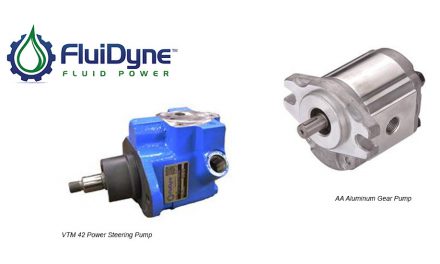John Harrison (00:11):
Hi, I’m John with FluiDyne and we get quite a few calls on how to determine displacement and rotation of eight, 10 V series pumps, especially once they come in without any tags or any information on them. So what we’re going to do in this video is just go over a few basic things to look for when you’re trying to decide and figure out what size pump and what the displacement is and what rotation.
John Harrison (00:33):
So here I have set up 45 CC pumps 31 design here, and 52 design here. Now 31 designs are a little bit easier to determine rotation. Usually you can view them from the back and see which way the compensators are pointing. So on this particular one here it’s right-handed, as you can see, if you’re looking at it from the back of the pump, your compensator adjustments are pointing off to the right.
John Harrison (00:59):
Your pressure side is also on the right, so that’ll help you determine rotation. Now, for some reason, the compensator is gone or you get the unit taken apart. When it’s received, there are other ways to determine what the rotation is on the pumps. You can check the lens plate. The lens plate always has these decompression grooves here and compression grooves, depending on which way they’re pointing, that’s going to determine rotation. So this one in particular is right-handed it narrows down to a point here, but then opens up towards the right-hand side. So that’s right-hand rotation. Another way is for your cradle, where you could do is this cradle has two holes on it on one side, and then on the backside, it has a large slot and a smaller slot. The large slide is usually goes on the pressure side of the pump when it’s installed, but it’s rotation specific.
John Harrison (01:56):
So if you’re looking at it from the face, with this particular, these two dots pointing off to the right and your large slot at 12 o’clock that’s for a right-handed pump. Adversely, if it’s going the opposite direction, if you have one that’s up top here, and your two holes are on the left-hand side, that’s for a left-hand rotation. And here we have a left-hand rotation, 31 series pump. Again, you can see viewing it from the back, the controls are pointing off to the left. So if you’re looking at it from the back, controls are pointing out to the left pressure side is also on the left. That’s going to tell you it’s a left-handed pump trying to figure out your displacement that is fairly easy. You can take the rotating group and each piston inside the rotating group. You can measure the ODI diameter of it, and it’ll tell you what displacement these pumps are.
John Harrison (03:00):
So that’s all you need is just one measurement right here on a diameter. Same thing with the 52 design pumps. So on the 52 design pumps, if we’re going to try and determine rotation, where you can do is check the back. Since both compensators are kind of pointing off the rear of the pump. And what you can see is on one side, the pressure side is on the right with the compensator at 12 o’clock on the other one pressure side is on the left. So this is a right-handed pump. This is a left-handed pump. If they come in apart, again, just like the other pumps, these wafer plates will also determine what rotation and you can use the same thinking as far as which way these groves kind of open up. Um, if you’re changing rotation on either one of these poems, there are rotation specific parts.
John Harrison (03:56):
Um, one is the lens plate, the valve block and the cradle. Uh, like I discussed earlier, as far as determining rotation, the 52 design, these cradles, they look the same, but they are not. So for a right hand, again, the larger slot is on the right if you’re viewing it from the face. And there’s also a little tiny hole here for lubrication on the pressure side. So if you’re looking at this from the face on the right-hand side is your lubricating hole on the pressure side and also your large groove. So this is a right-handed cradle, those that are rotation specific. So if you’re rebuilding a pump or trying to change rotation on them, you’re gonna want to make sure that you get all three components, the valve block, the lens plate, and the cradle. Any other repair parts are kind of, uh, interchangeable the rotating group. Um, there are differences between the bearings and the seals. So you will have to determine if they’re 52 or 31 design. Those are some of the basic things you can look for when trying to determine rotation of a pump. If you’re not sure and displacement of a pump.
John Harrison (05:08):
Make sure you like us on Facebook, subscribe to our YouTube channel and check us out online. We do have live chat. So if you have any questions, feel free to go on there and ask, or give us a call and chat with us live.
For information on, or to purchase a FluiDyne Pump click here.











